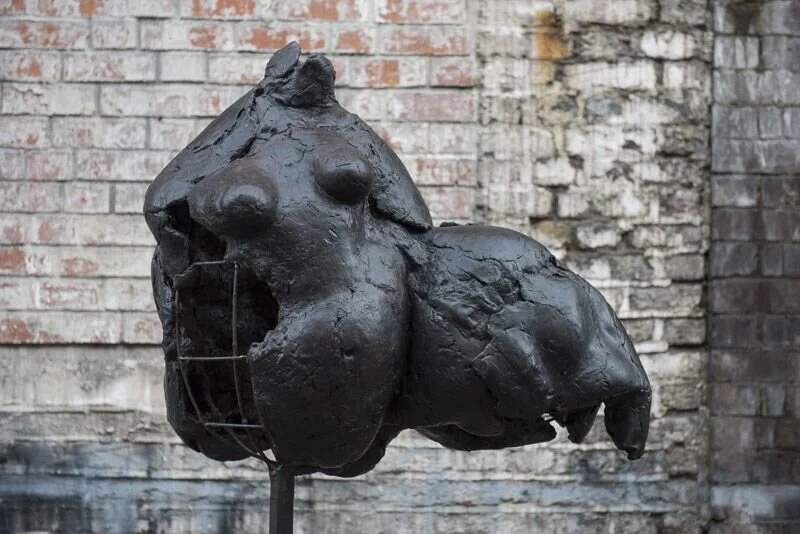In Praise of Pathos: Notes on a poetics of fragments
There are certain qualities of literary fragments that make them an exceptionally attractive and creative form:
Fragments don’t tell an actual story; they just trigger a narration mechanism. This way numerous different narrations attain possibility. Although they can function independently, they can also be part of something bigger. They hence give a creative freedom to the reader’s imagination.
Fragments are connected to something missing or destructed, but at the same time they can be something that is about to be created -in a different direction/ dimension-, they are thus in a kind of permanent state of becoming.
Fragments are alive the same way poetry is, open as such to interpretations.
Sappho’s verses are almost all in fragments; some preserved on papyrus, while others found as citations in the works of several ancient authors. Her huge poetic dynamic, segmented therefore by circumstances, is disseminated to a whole universe of interpretations.
Eros melter of limbs (now again) stirs me-
Sweetbitter unmanageable creature who steals in
If with her recent Tools of Endearment Kalliopi Lemos invites Woman to a psychic rise as a body of power, in All is to be Dared her appeal is for physical emancipation through emotional liberation.
This sensual corporality is mostly registered on her relief women wrapped in gauze, who look like they just found their third dimension and on the three peculiar women-birds’ sculptures as well. For the making of the latter Lemos abandons the cold and impenetrable steel she used for Tools of Endearment, for wax; an organic, vulnerable and sensual material. Soft and warm, greasy and sweaty. Just like flesh.
And cold sweat holds me and shaking
In Greek lyric poetry, eros is an experience of melting, says poet, essayist and Sappho’s translator Ann Carson. The god of desire himself is traditionally called ‘melter of limbs’. (…) The lover whom he victimizes is a piece of wax dissolving at his touch.
Those ambiguous wax creatures, balancing endlessly between materialization and destruction in their undefined shapes, fragments of creation just like Sappho’s verses, are exposing shamelessly their insides, their prison and agony.
Three is a magic number for the ancient Greek myths, the end, the middle and the beginning according to Pythagoras. Three were the Moeraes (Fates) and the Charites (Graces) and three the Erinyes (Furies), the Harpies (Harpy sisters) and the Gorgons (Dreadful).
And it’s through those sculptures and the multiple myths they carry, ‘surrounding’ the tender falling of Sappho’s verses in the main gallery area, that the function of fragment is activated.
Kind or fearful the wounded semi-made deities, hybrids of Louise Bourgeois’ frantic feminine forms and Venus of Willendorf’s sensual shape, generate several allegories about the eternal woman’s struggle against her tender chaotic inside and a monolithic supressing and abusive outside.
It is a struggle with obsession, with jealousy and despair, with love and desire.
Being a woman was never easy after all.
I don’t know what to do two states of mind in me
Sappho’s verses, like a rain made of therapeutic gauze -here is the trauma and here is the healing- or long hair -a typical symbol of femininity-, are dominating the space with their pathos and eroticism, mingling with each other in all new meanings.
Sappho’s presence seems possessing. Her words are full of a loving body, a body with melted limbs, with no speaking left, fire burning its skin, with lost eyesight and ears drumming, cold sweat, shaking, becoming greener than grass.
This exact voluptuous and full of senses body, at the definitive moment when the woman let love conquer her, runs as an aura through the whole exhibition. But it is not just a body of desire, it is also a body of inevitable despair. Eros is sweet, but it’s bitter too.
Come to me now. Drive off this brutal Distress. Accomplish what my pride Demands. Come, please, and in this battle
Stand at my side.
It is the brutal Distress or the Agony, as Roland Barthes describes the fear of a danger, an injury, an abandonment, a revulsion, the amorous subject is overwhelmed with, that is fully expressed in Lemos’ Boxes.
Here Lemos returns to cold and hard steel, to barbed wire and other threatening materials that describe an inner prison. The artist, choosing to use her photos inside the boxes, seems to wear in empathy the dress of heroines-symbols, crushed between the intensity of their feelings and society’s or/and their lover’s cruelness, drowned by their desire and guiltiness.
She incarnates Norma’s prayer to Casta Diva, Anna Karenina’s fall or Emily Dickinson’s Wild Nights. She is Helen of Troy and Fedra.
But all is to be dared, because even a person of poverty
Taking a step beyond the balance that was always her pursuit Lemos returns to an area she had first, partly, explored in I am I Between Worlds and Between Shadows, the incrimination of feminine sexuality and the consequent self-restrain and guilt, claiming woman’s right to the exaggeration of a Pathos.
Her characteristic use of mythos functions here again through deduction. Her works are the fragments of possible mythical or literary narratives that generate successive new hypothetical stories.
If for Griselda Pollock women’s claims for an autonomous and self defined sexuality can operate as a metaphor for woman’s struggle for personal liberationiv, then, in their exact temporality -100 years after the first women voting and during a massive movement through which numerous women finally found the courage to speak up about abuse and harassment- Lemos’ stories become the metaphor:
Sappho, according to Carson, through her verses expresses the creation of a demand -that of the absolute feminine Pathos- to which she finally consents, although it splits her in twov; Lemos accordingly, through fragments -Sappho’s and hers- points out the actual ecumenism of Sappho’s demand, inviting all women to consent to it since it’s now that All is to be Dared.
London 2018
